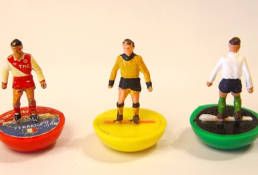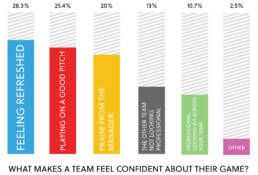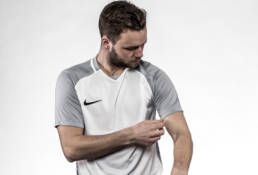We’ve all seen the film where the football team are about to step out onto the pitch for their do-or-die match. Their kit is mismatched and their expressions are that of defeat. Then, at the very last second, someone rocks up with a ‘proper’ kit for them and suddenly they are set for battle, and yep, you’ve guessed it, they go on to win the game.
Clichéd as it may sound, this scenario isn’t too far removed from reality. Here we take a look at the psychology behind the football kit, and how the right kit can increase team spirit, and ultimately improve play.
Read on to find out:
+ What makes a team feel confident about their game?
+ What elements determine a professional kit?
+ Is the colour of a football kit linked to the club’s success
+ Does colour psychology apply to the goalkeepers kit?
+ Famous Kit Trivia

What makes a team feel confident about their game?
To find out more about team confidence and what makes a team step onto the pitch feeling like winners we surveyed 515 UK males, aged between 18-44, we asked the question:
“If you were to play a competitive game of football what would make you feel confident about your game?”
This is how they responded:

Alongside the fundamental requirements of being physically able to play and practical elements such as the condition of the pitch, a professional kit (be that the player’s own kit or the opposition’s lack of kit) pulled in almost a quarter of the votes.
This enforces the argument that psychologically, a ‘proper’ kit increases confidence, creates a feeling of team solidarity and, essentially, makes the other team feel as though they have a game on their hands.
The survey also revealed the following stats:
- The 25-34 age group placed a higher importance on having a professional looking kit than the other age groups
- Players aged 35-44 gained more confidence from the other team not looking professional than on having a decent kit themselves, inferring that this made the other team appear weaker
- Praise from the manager had equal importance across all age groups
- The quality of the pitch was most important to the younger 18-24 age bracket
- All age groups were in agreement that a good night’s sleep was the best way to ensure that they would feel confident on the pitch

What elements determine a ‘professional’ kit?
When it comes to team kits there are no hard and fast rules, apart from ensuring that all team member’s kits are matching and of good enough quality to endure the inevitable mud, sweat and tears. There are other signals, however, that further justify the teams perceived professionalism, including:
Named and Numbered Shirts – Additional detail such as numbers and names help enforce that a team is established, with committed players who regularly train and play together and therefore warrant their own jersey.
Sponsorship – Sponsorship also speaks volumes in terms of making a team appear professional, indicating that a company thinks the team is a good representation of their brand, in essence, putting their money where their mouth is.
As highlighted in our survey, a team without the ‘professional edge’ is seen to be less of a threat than one wearing a slick kit, with sponsorship branding and personalised details further enforcing the message.

Is the colour of a football kit linked to the club’s success?
Over the years, numerous studies have been carried out to determine whether there is a link between shirt colour and success. Findings have been unanimous, highlighting that sports people competing in red win more matches, or score 10% more than they do in any other colour.

*Proportion of teams winning the English Football League 1947-2003 within each shirt colour category – Journal of Sports Sciences April 2008
This could be for the following reasons:
- Red is synonymous for increasing confidence, giving players/teams a psychological boost.
- Red can be perceived as being more aggressive or dominant, hence unnerving opponents.
- On a practical level, red shirts are easier to see, possibly increasing the accuracy of passes.
These findings could go towards explaining why top British clubs Manchester United, Liverpool and Arsenal are continuously successful, season after season. Arguably, the ongoing success of these teams can also give those who wear red a confidence boost by default.
Interestingly, things aren’t quite so plan sailing when the red shirts are off. Man Utd famously faced a 3-0 defeat against Southampton when wearing their ‘invisible’ grey kit back in ’96. The team simply couldn’t see each other on the pitch, prompting Fergie to order the team to change shirts at half time.
On an International level, it doesn’t go unnoticed that England’s victorious World Cup team in 1966 wore red, instead of their usual white. They have not won a World Cup or European Championship since, so maybe it’s time to dig out the red again?

Does colour psychology apply to the goalkeepers kit?
Goalies wear a different coloured strip to the rest of the team so that they are easy to differentiate against the other players. There is no strict rule as to what this colour should be, although there are two opposing schools of thought on the subject.
Traditionally, teams went under the belief that goalies should be as inconspicuous as possible to make them harder to spot in the goal and therefore harder to aim past. This is one of the reasons why green is a popular colour for goalkeepers shirts, as green can be difficult to spot against the grass.
An opposing view, however, has been raised by research carried out by Dr Iain Greenlees, Reader in Sport and Exercise Psychology. Greenlees’ research revealed that significantly fewer goals were scored against a goalkeeper wearing a red shirt, as opposed to a green, yellow or blue shirt. Although one would assume that it would be easier to aim away from such a distinctive colour, the red subconsciously attracts the eye of the striker, who unwittingly aims the ball towards the colour.

Famous Kit Trivia
There’s a lot more to picking a kit than you may assume, as these famous World Cup stories suggest:
1.After deciding their blue collared shirts were cursed, Brazil ran a newspaper competition to redesign their kit in the colours of the Brazilian flag. An eighteen year old writer and illustrator won the completion, designing the now legendary kit that Brazil went on to win five World Cups in.
2. When England played Czechoslovakia in the 1970 World Cup finals in Mexico, they stepped out in pale blue shirts. However, the Czechs played in white, making it almost impossible to differentiate between the two teams, especially on black and white TV.
- Maradona chose the light blue shirt that he wore for his famous ‘Hand of God’ moment, stating “That’s a nice jersey. We’ll beat England in that.”
4. A kit clash also caused problems between France and Hungary in 1978, resulting in a delayed game and Les Bleus borrowing a makeshift green and white striped kit from local club Atletico Kimberley. The kit was delivered by police car, complete with emergency sirens, and goal scorer Rocheteau wore No18 on his shorts and No7 on his back.
How useful was this post?
Average rating 3.3 / 5. Vote count: 3
No votes so far! Be the first to rate this post.

eeeeeeeeeeeeeeeeeeeeeeeeeeeeeeeeee